Cross-Domain Travel Mode Detection for Electric Micro-Mobility Using Semi-Supervised Learning
Abstract
1. Introduction
2. Related Research
2.1. Mode-Detection Models
2.2. Micro-Mobility Mode Detection
3. Methodology
3.1. Dataset Description
3.2. Definitions
- Waypoint. A timestamped position over a measured GNSS trajectory.
- GNSS trajectory. A sequence of waypoints measured by a single GNSS position log. A GNSS trajectory can store hours of positioning data, depicting a user’s series of trips and travel activities, and can include a manifold of travel modes.
- Sequence. An array of waypoints ordered by their time stamp. We infer that consecutive waypoints in a sequence are separated by less than 30 s.
- Trip. Part of a trajectory that may contain several segments.
- Segment. Part of a trip that was traveled using a single travel mode.
- Sliding window. Portion of a segment used to calculate the travel properties over a single waypoint, within the context of the trip. A sliding window is composed of the queried waypoint and its preceding and succeeding n neighbors.
3.3. Model Architecture
3.4. Model Features
3.5. Model Evaluation
3.5.1. Training and Evaluation
3.5.2. Score Metrics
3.6. Travel Property Analysis
4. Results
4.1. Descriptive Analysis
4.2. Training Results
4.3. Validation Results
4.4. xSeCA Variations and Comparison to XGBoost
4.5. Cross-Domain Analysis
4.6. Travel Property Analysis
5. Discussion and Conclusions
Author Contributions
Funding
Acknowledgments
Conflicts of Interest
Appendix A. Descriptive Analysis
Appendix A.1. Speed

Appendix A.2. Relative Distance

Appendix A.3. Acceleration

Appendix A.4. Jerk

Appendix A.5. Bearing


Appendix A.6. Bearing Rate

Appendix A.7. Ramer–Douglas–Peucker

Appendix B. Shapley Analysis over the Validation Dataset
Appendix B.1. Speed
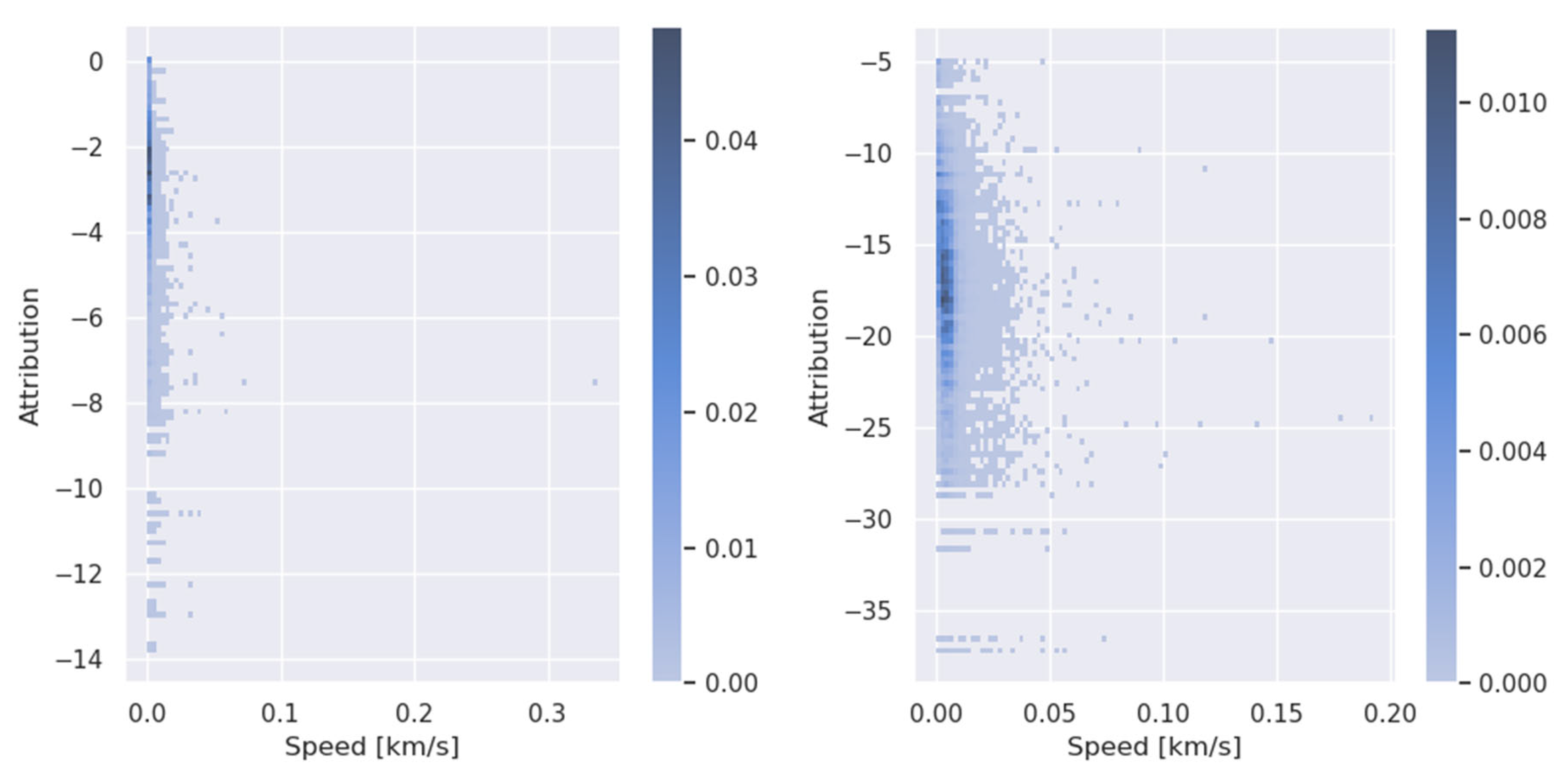
Appendix B.2. Relative Distance
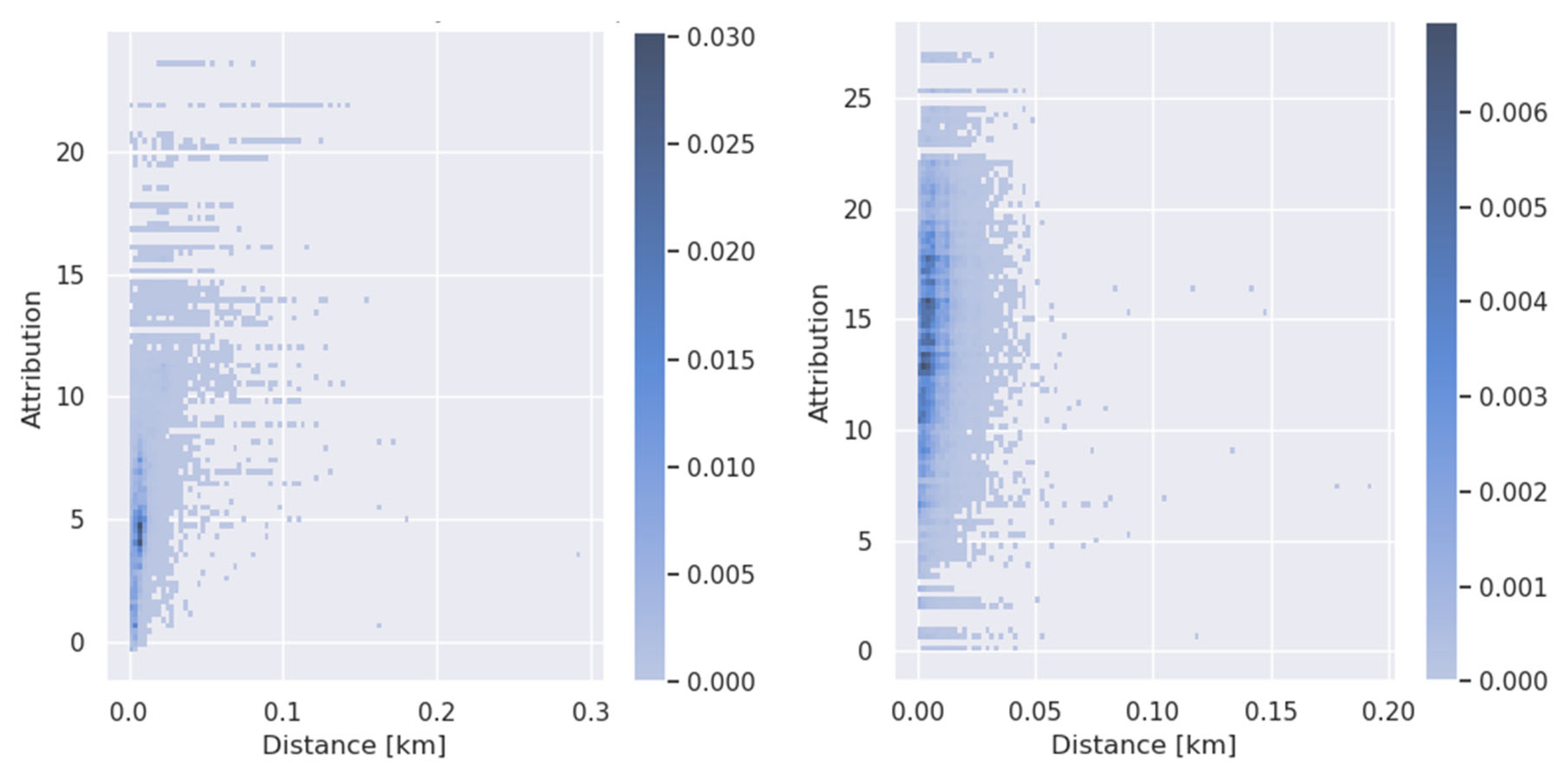

Appendix B.3. Acceleration and Jerk
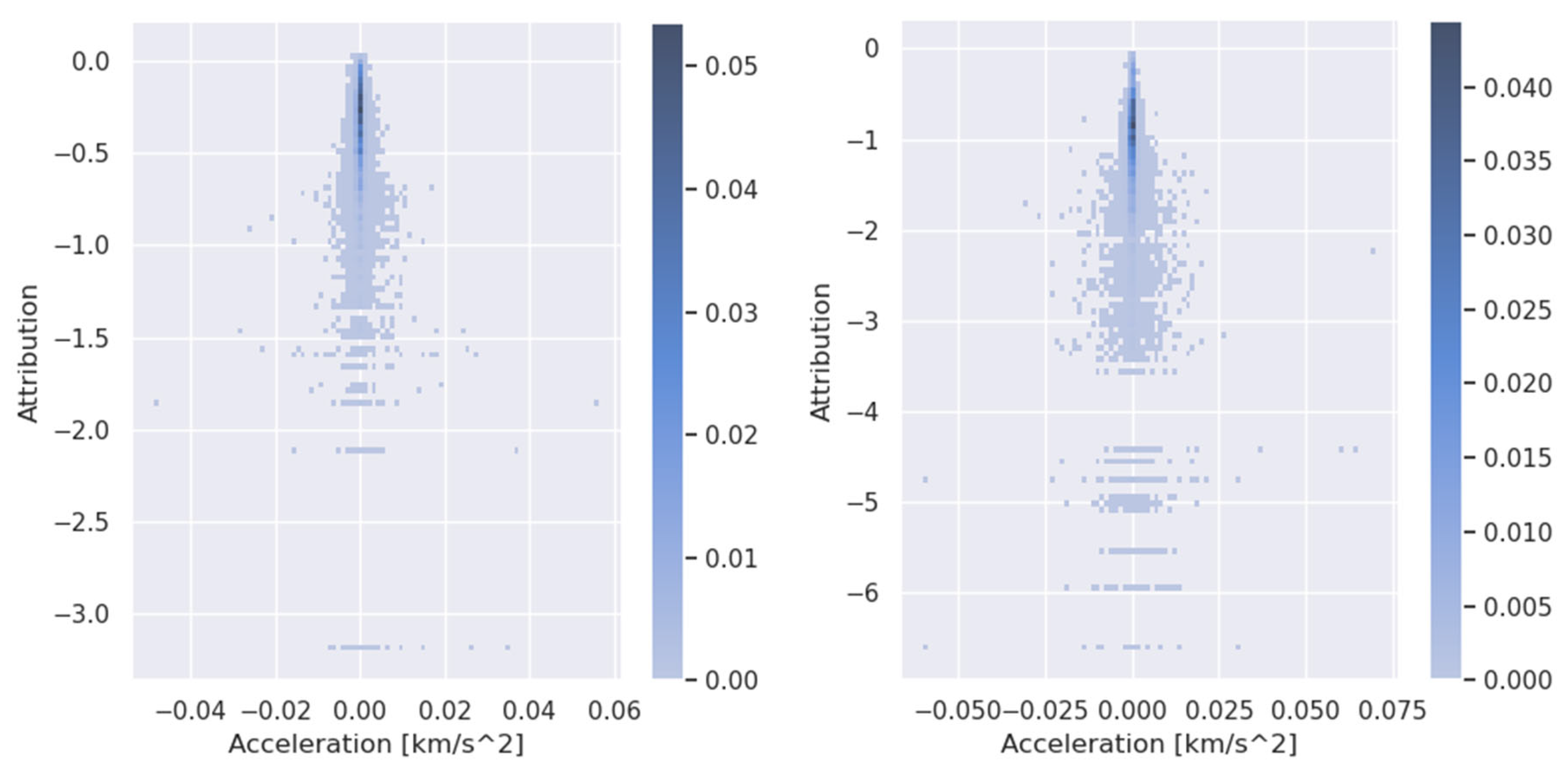
Appendix B.4. Bearing
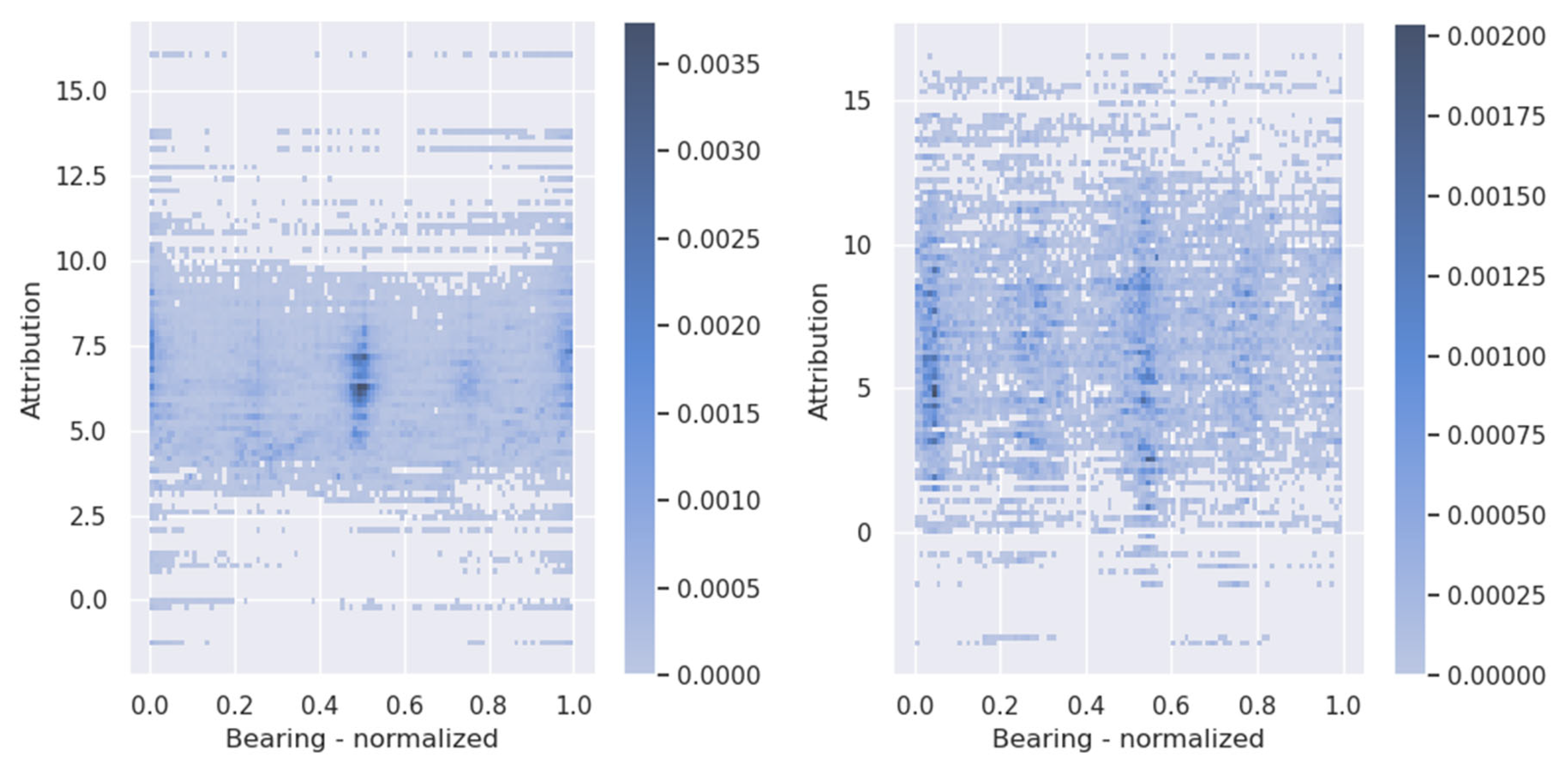
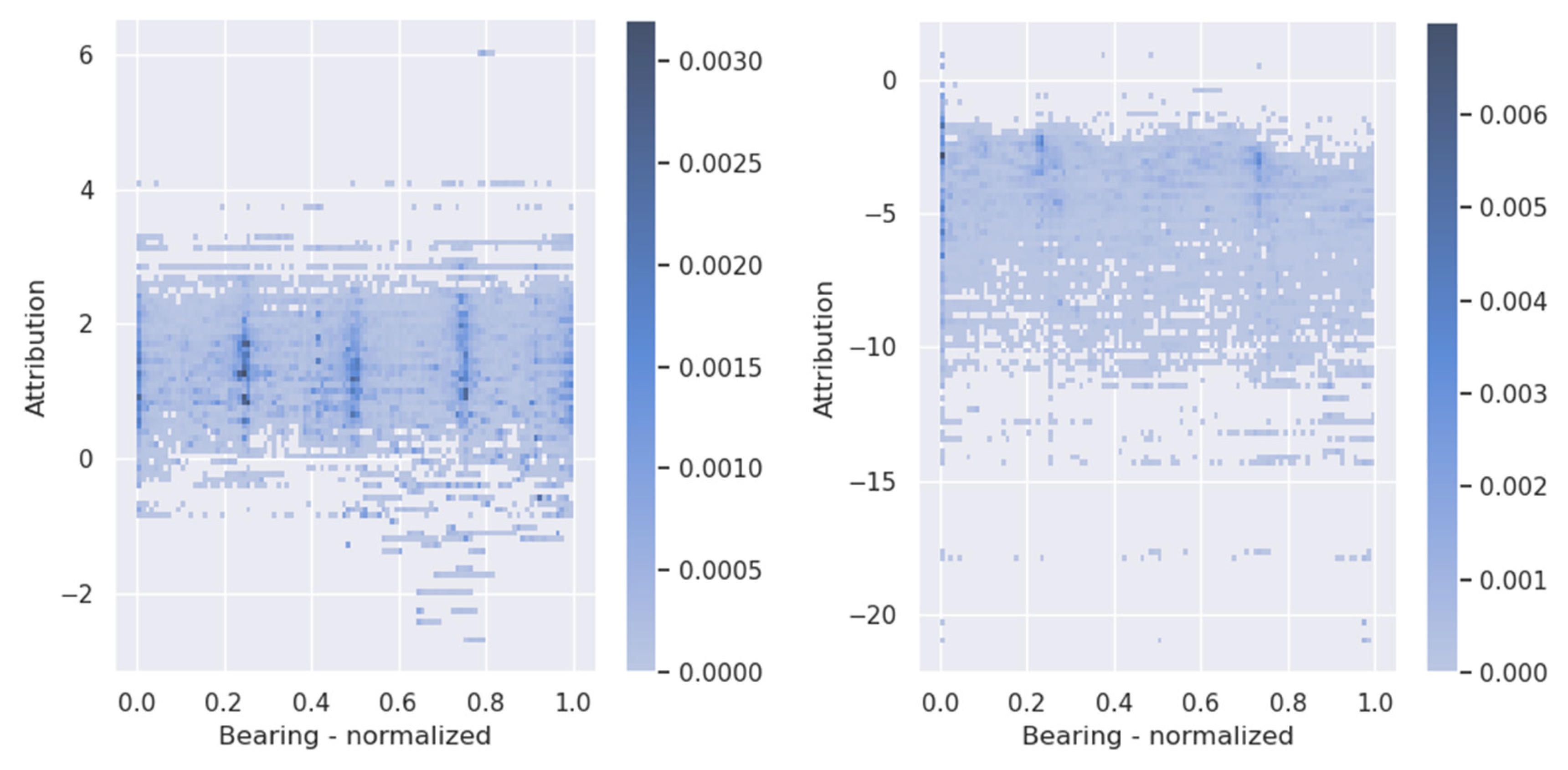
Appendix B.5. Bearing Rate
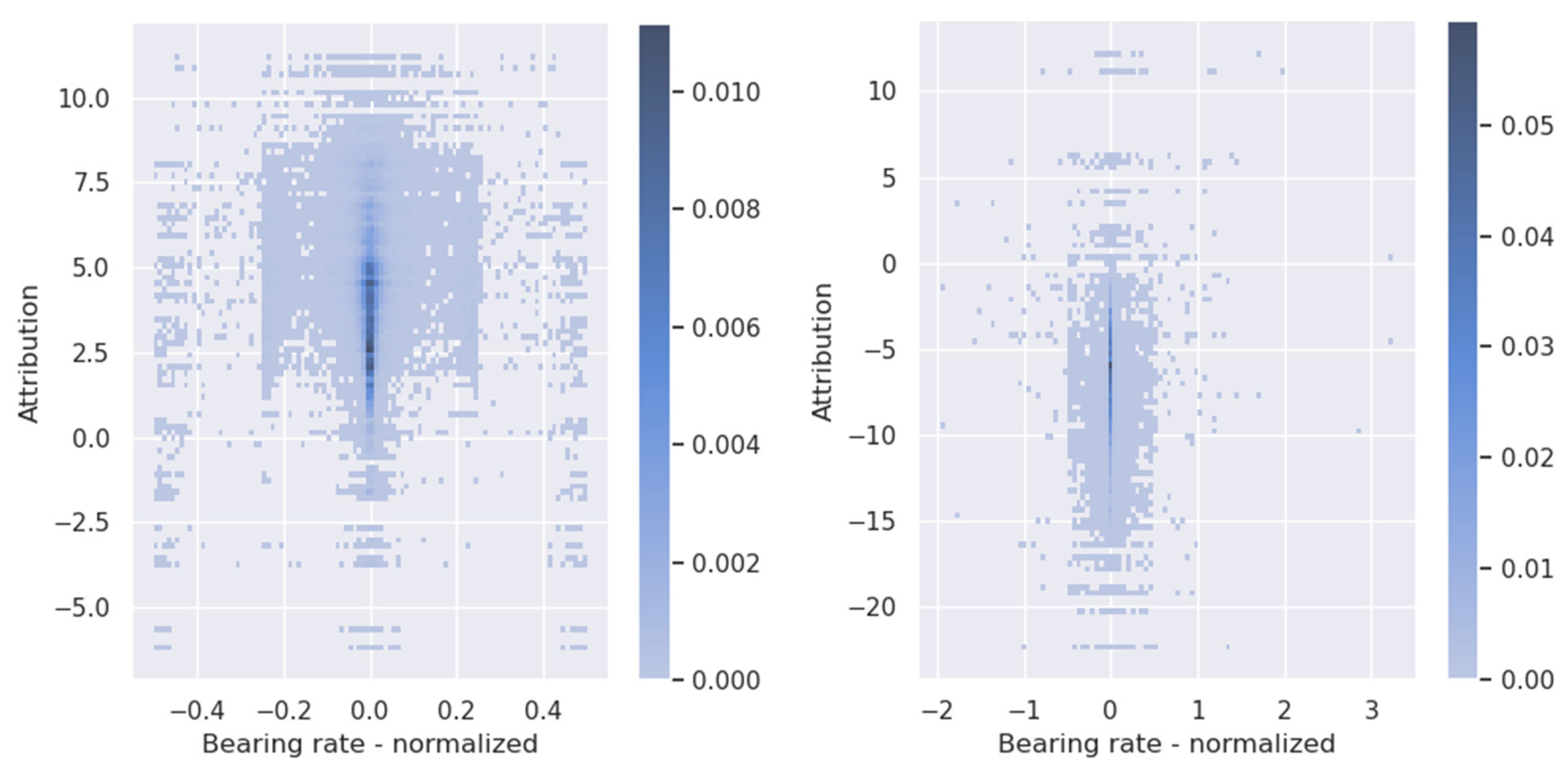

Appendix B.6. Ramer–Douglas–Peucker

References
- Lindsey, R.; Santos, G. Addressing transportation and environmental externalities with economics: Are policy makers listening? Res. Transp. Econ. 2020, 82, 100872. [Google Scholar] [CrossRef]
- Zhang, C.; Du, B.; Zheng, Z.; Shen, J. Space sharing between pedestrians and micro-mobility vehicles: A systematic review. Transp. Res. Part D Transp. Environ. 2023, 116, 103629. [Google Scholar] [CrossRef]
- Abduljabbar, R.L.; Liyanage, S.; Dia, H. The role of micro-mobility in shaping sustainable cities: A systematic literature review. Transp. Res. Part D Transp. Environ. 2021, 92, 102734. [Google Scholar] [CrossRef]
- Schumann, H.H.; Haitao, H.; Quddus, M. Passively generated big data for micro-mobility: State-of-the-art and future research directions. Transp. Res. Part D Transp. Environ. 2023, 121, 103795. [Google Scholar] [CrossRef]
- Kaya, Ö. Designing green and safe micro mobility routes: An advanced geo-analytic decision system based approach to sustainable urban infrastructure. Eng. Sci. Technol. Int. J. 2025, 64, 102027. [Google Scholar] [CrossRef]
- Altintasi, O.; Yalcinkaya, S. Siting charging stations and identifying safe and convenient routes for environmentally sustainable e-scooter systems. Sustain. Cities Soc. 2022, 84, 104020. [Google Scholar] [CrossRef]
- Toole, J.L.; Colak, S.; Sturt, B.; Alexander, L.P.; Evsukoff, A.; González, M.C. The path most traveled: Travel demand estimation using big data resources. Transp. Res. Part C Emerg. Technol. 2015, 58, 162–177. [Google Scholar] [CrossRef]
- Klöckner, C.A.; Friedrichsmeier, T. A multi-level approach to travel mode choice—How person characteristics and situation specific aspects determine car use in a student sample. Transp. Res. Part F Traffic Psychol. Behav. 2011, 14, 261–277. [Google Scholar] [CrossRef]
- Tokey, A.I.; Shioma, S.A.; Jamal, S. Analysis of spatiotemporal dynamics of e-scooter usage in Minneapolis: Effects of the built and social environment. Multimodal Transp. 2022, 1, 100037. [Google Scholar] [CrossRef]
- Sui, Y.; Zhang, H.; Song, X.; Shao, F.; Yu, X.; Shibasaki, R.; Sun, R.; Yuan, M.; Wang, C.; Li, S.; et al. GPS data in urban online ride-hailing: A comparative analysis on fuel consumption and emissions. J. Clean. Prod. 2019, 227, 495–505. [Google Scholar] [CrossRef]
- Prelipcean, A.C.; Gidófalvi, G.; Susilo, Y.O. Transportation mode detection—An in-depth review of applicability and reliability. Transp. Rev. 2017, 37, 442–464. [Google Scholar] [CrossRef]
- Sarker, M.A.A.; Asgari, H.; Chowdhury, A.Z.; Jin, X. Exploring Micromobility Choice Behavior across Different Mode Users Using Machine Learning Methods. Multimodal Transp. 2024, 3, 100167. [Google Scholar] [CrossRef]
- Wolf, J.; Guensler, R.; Bachman, W. Elimination of the travel diary: Experiment to derive trip purpose from global positioning system travel data. Transp. Res. Rec. J. Transp. Res. Board 2001, 1768, 125–134. [Google Scholar] [CrossRef]
- Angel, A.; Cohen, A.; Dalyot, S.; Plaut, P. Estimating pedestrian traffic with Bluetooth sensor technology. Geo-Spat. Inf. Sci. 2023, 27, 1391–1404. [Google Scholar] [CrossRef]
- Mun, M.; Estrin, D.; Burke, J.; Hansen, M. Parsimonious mobility classification using GSM and WiFi traces. In Proceedings of the Fifth Workshop on Embedded Networked Sensors (HotEmNets), Charlottesville, VA, USA, 2–3 June 2008; pp. 1–5. [Google Scholar]
- Argyros, D.; Jensen, A.F.; Rich, J.; Dalyot, S. Riding smooth: A cost-benefit assessment of surface quality on Copenhagen’s bicycle network. Sustain. Cities Soc. 2024, 108, 105473. [Google Scholar] [CrossRef]
- Bohte, W.; Maat, K. Deriving and validating trip purposes and travel modes for multi-day GPS-based travel surveys: A large-scale application in the Netherlands. Transp. Res. Part C Emerg. Technol. 2009, 17, 285–297. [Google Scholar] [CrossRef]
- Sadeghian, P.; Håkansson, J.; Zhao, X. Review and evaluation of methods in transport mode detection based on GPS tracking data. J. Traffic Transp. Eng. (Engl. Ed.) 2021, 8, 467–482. [Google Scholar] [CrossRef]
- Martin, B.D.; Addona, V.; Wolfson, J.; Adomavicius, G.; Fan, Y. Methods for real-time prediction of the mode of travel using smartphone-based GPS and accelerometer data. Sensors 2017, 17, 2058. [Google Scholar] [CrossRef]
- Yazdizadeh, A.; Patterson, Z.; Farooq, B. An automated approach from GPS traces to complete trip information. Int. J. Transp. Sci. Technol. 2019, 8, 82–100. [Google Scholar] [CrossRef]
- Zha, W.; Guo, Y.; Li, B.; Liu, D.; Zhang, X. Individual Travel Transportation Modes Identification Based on Deep Learning Algorithm of Attention Mechanism. In Proceedings of the 2019 Chinese Automation Congress (CAC), Hangzhou, China, 22–24 November 2019; pp. 3609–3614. [Google Scholar]
- Zhou, X.; Yu, W.; Sullivan, W.C. Making pervasive sensing possible: Effective travel mode sensing based on smartphones. Comput. Environ. Urban Syst. 2016, 58, 52–59. [Google Scholar] [CrossRef]
- Stenneth, L.; Wolfson, O.; Yu, P.S.; Xu, B. Transportation mode detection using mobile phones and GIS information. In Proceedings of the 19th ACM SIGSPATIAL International Conference on Advances in Geographic Information Systems, Chicago, IL, USA, 1–4 November 2011; pp. 54–63. [Google Scholar]
- Roy, A.; Fuller, D.; Stanley, K.; Nelson, T. Classifying transport mode from global positioning systems and accelerometer data: A machine learning approach. Findings 2020, 1–8. [Google Scholar] [CrossRef]
- Xiao, G.; Cheng, Q.; Zhang, C. Detecting travel modes using rule-based classification system and Gaussian process classifier. IEEE Access 2019, 7, 116741–116752. [Google Scholar] [CrossRef]
- Xiao, Z.; Wang, Y.; Fu, K.; Wu, F. Identifying different transportation modes from trajectory data using tree-based ensemble classifiers. ISPRS Int. J. Geo-Inf. 2017, 6, 57. [Google Scholar] [CrossRef]
- Wang, B.; Gao, L.; Juan, Z. Travel mode detection using GPS data and socioeconomic attributes based on a random forest classifier. IEEE Trans. Intell. Transp. Syst. 2017, 19, 1547–1558. [Google Scholar] [CrossRef]
- Yazdizadeh, A.; Patterson, Z.; Farooq, B. Ensemble convolutional neural networks for mode inference in smartphone travel survey. IEEE Trans. Intell. Transp. Syst. 2019, 21, 2232–2239. [Google Scholar] [CrossRef]
- Zhang, L.; Dalyot, S.; Eggert, D.; Sester, M. Multi-stage approach to travel-mode segmentation and classification of GPS traces. Geospatial Data Infrastructure: From Data Acquisition and Updating to Smarter Services. Int. Arch. Photogramm. Remote Sens. Spat. Inf. Sci. 2011, W25, 87–93. [Google Scholar] [CrossRef]
- Dabiri, S.; Lu, C.-T.; Heaslip, K.; Reddy, C.K. Semi-supervised deep learning approach for transportation mode identification using GPS trajectory data. IEEE Trans. Knowl. Data Eng. 2019, 32, 1010–1023. [Google Scholar] [CrossRef]
- James, J.Q. Semi-supervised deep ensemble learning for travel mode identification. Transp. Res. Part C Emerg. Technol. 2020, 112, 120–135. [Google Scholar]
- Li, L.; Zhu, J.; Zhang, H.; Tan, H.; Du, B.; Ran, B. Coupled application of generative adversarial networks and conventional neural networks for travel mode detection using GPS data. Transp. Res. Part A Policy Pract. 2020, 136, 282–292. [Google Scholar] [CrossRef]
- Wood, J.; Bradley, S.; Hamidi, S. Preparing for Progress: Establishing Guidelines for the Regulation, Safe Integration, and Equitable Usage of Dockless Electric Scooters in American Cities. 2019. Available online: https://rosap.ntl.bts.gov/view/dot/54415 (accessed on 23 May 2023).
- Brunner, H.; Hirz, M.; Hirschberg, W.; Fallast, K. Evaluation of various means of transport for urban areas. Energy Sustain. Soc. 2018, 8, 9. [Google Scholar] [CrossRef]
- Gilroy, S.; Mullins, D.; Jones, E.; Parsi, A.; Glavin, M. E-Scooter Rider detection and classification in dense urban environments. Results Eng. 2022, 16, 100677. [Google Scholar] [CrossRef]
- Xiao, G.; Juan, Z.; Zhang, C. Travel mode detection based on GPS track data and Bayesian networks. Comput. Environ. Urban Syst. 2015, 54, 14–22. [Google Scholar] [CrossRef]
- Liu, L.; Li, Y.; Gruyer, D.; Tu, M. Non-linear relationship between built environment and active travel: A hybrid model considering spatial heterogeneity. Int. J. Transp. Sci. Technol. 2024; in press. [Google Scholar] [CrossRef]
- Fang, Z.; Wu, D.; Pan, L.; Chen, L.; Gao, Y. When Transfer Learning Meets Cross-City Urban Flow Prediction: Spatio-Temporal Adaptation Matters. In Proceedings of the Thirty-First International Joint Conference on Artificial Intelligence, Vienna, Austria, 23–29 July 2022; Volume 22, pp. 2030–2036. [Google Scholar]
- Jain, Y.; Pandey, K. Transforming Urban Mobility: A Systematic Review of AI-Based Traffic Optimization Techniques. Arch. Comput. Methods Eng. 2025, 1–37. [Google Scholar] [CrossRef]
- Alaoui, F.T.; Fourati, H.; Kibangou, A.; Robu, B.; Vuillerme, N. Kick-scooters detection in sensor-based transportation mode classification methods. IFAC-Pap. 2021, 54, 81–86. [Google Scholar] [CrossRef]
- Matkovic, V.; Waltereit, M.; Zdankin, P.; Weis, T. Towards bike type and e-scooter classification with smartphone sensors. In Proceedings of the MobiQuitous 2020—17th EAI International Conference on Mobile and Ubiquitous Systems: Computing, Networking and Services, Darmstadt, Germany, 7–9 December 2020; pp. 395–404. [Google Scholar]
- Zheng, Y.; Xie, X.; Ma, W.Y. GeoLife: A collaborative social networking service among user, location and trajectory. IEEE Data Eng. Bull. 2010, 33, 32–39. [Google Scholar]
- Bernitt, C. The Choice Between E-Bike and Car—Economical Decision by Data Mining. Unpublished Bachelor’s Thesis, Technical University of Denmark, Lyngby, Denmark, 2017. [Google Scholar]
- Shankari, K.; Fuerst, J.; Argerich, M.F.; Avramidis, E.; Zhang, J. MobilityNet: Towards a Public Dataset for Multi-modal Mobility Research. In Proceedings of the ICLR 2020 Workshop on Tackling Climate Change with Machine Learning, Addis Ababa, Ethiopia, 26 April 2020. [Google Scholar]
- Sultan, J.; Ben-Haim, G.; Haunert, J.; Dalyot, S. Extracting spatial patterns in bicycle routes from crowdsourced data. Trans. GIS 2017, 21, 1321–1340. [Google Scholar] [CrossRef]
- Cohen, A.; Dalyot, S. Machine-learning prediction models for pedestrian traffic flow levels: Towards optimizing walking routes for blind pedestrians. Trans. GIS 2020, 24, 1264–1279. [Google Scholar] [CrossRef]
- Loshchilov, I.; Hutter, F. Decoupled weight decay regularization. arXiv 2017, arXiv:1711.05101. [Google Scholar]
- Reddi, S.J.; Kale, S.; Kumar, S. On the convergence of adam and beyond. arXiv 2019, arXiv:1904.09237. [Google Scholar] [CrossRef]
- Zou, Z.; Younes, H.; Erdoğan, S.; Wu, J. Exploratory analysis of real-time e-scooter trip data in Washington, DC. Transp. Res. Rec. J. Transp. Res. Board 2020, 2674, 285–299. [Google Scholar] [CrossRef]
- Douglas, D.H.; Peucker, T.K. Algorithms for the reduction of the number of points required to represent a digitized line or its caricature. Cartographica 1973, 10, 112–122. [Google Scholar]
- Li, T.; Kovaceva, J.; Dozza, M. Modeling collision avoidance maneuvers for micromobility vehicles. J. Saf. Res. 2023, 87, 232–243. [Google Scholar] [CrossRef]
- Strumbelj, E.; Kononenko, I. An efficient explanation of individual classifications using game theory. J. Mach. Learn. Res. 2010, 11, 1–18. [Google Scholar]
- Cafiso, S.; Di Graziano, A.; Marchetta, V.; Pappalardo, G. Urban road pavements monitoring and assessment using bike and e-scooter as probe vehicles. Case Stud. Constr. Mater. 2022, 16, e00889. [Google Scholar] [CrossRef]
- Zhang, Y.; Shi, X.; Zhang, S.; Abraham, A. A xgboost-based lane change prediction on time series data using feature engineering for autopilot vehicles. IEEE Trans. Intell. Transp. Syst. 2022, 23, 19187–19200. [Google Scholar] [CrossRef]
- Vlachogiannis, D.M.; Moura, S.; Macfarlane, J. Intersense: An XGBoost model for traffic regulator identification at intersections through crowdsourced GPS data. Transp. Res. Part C Emerg. Technol. 2023, 151, 104112. [Google Scholar] [CrossRef]
- Guo, M.; Liang, S.; Zhao, L.; Wang, P. Transportation mode recognition with deep forest based on GPS data. IEEE Access 2020, 8, 150891–150901. [Google Scholar] [CrossRef]
- Ma, Q.; Yang, H.; Mayhue, A.; Sun, Y.; Huang, Z.; Ma, Y. E-Scooter safety: The riding risk analysis based on mobile sensing data. Accid. Anal. Prev. 2021, 151, 105954. [Google Scholar] [CrossRef]
- Reddi, S.; Charles, Z.; Zaheer, M.; Garrett, Z.; Rush, K.; Konečný, J.; Kumar, S.; McMahan, H.B. Adaptive federated optimization. arXiv 2020, arXiv:2003.00295. [Google Scholar]
- Ezequiel, C.E.J.; Gjoreski, M.; Langheinrich, M. Federated learning for privacy-aware human mobility modeling. Front. Artif. Intell. 2022, 5, 867046. [Google Scholar] [CrossRef]
- Roy, A.; Fuller, D.; Nelson, T.; Kedron, P. Assessing the role of geographic context in transportation mode detection from GPS data. J. Transp. Geogr. 2022, 100, 103330. [Google Scholar] [CrossRef]
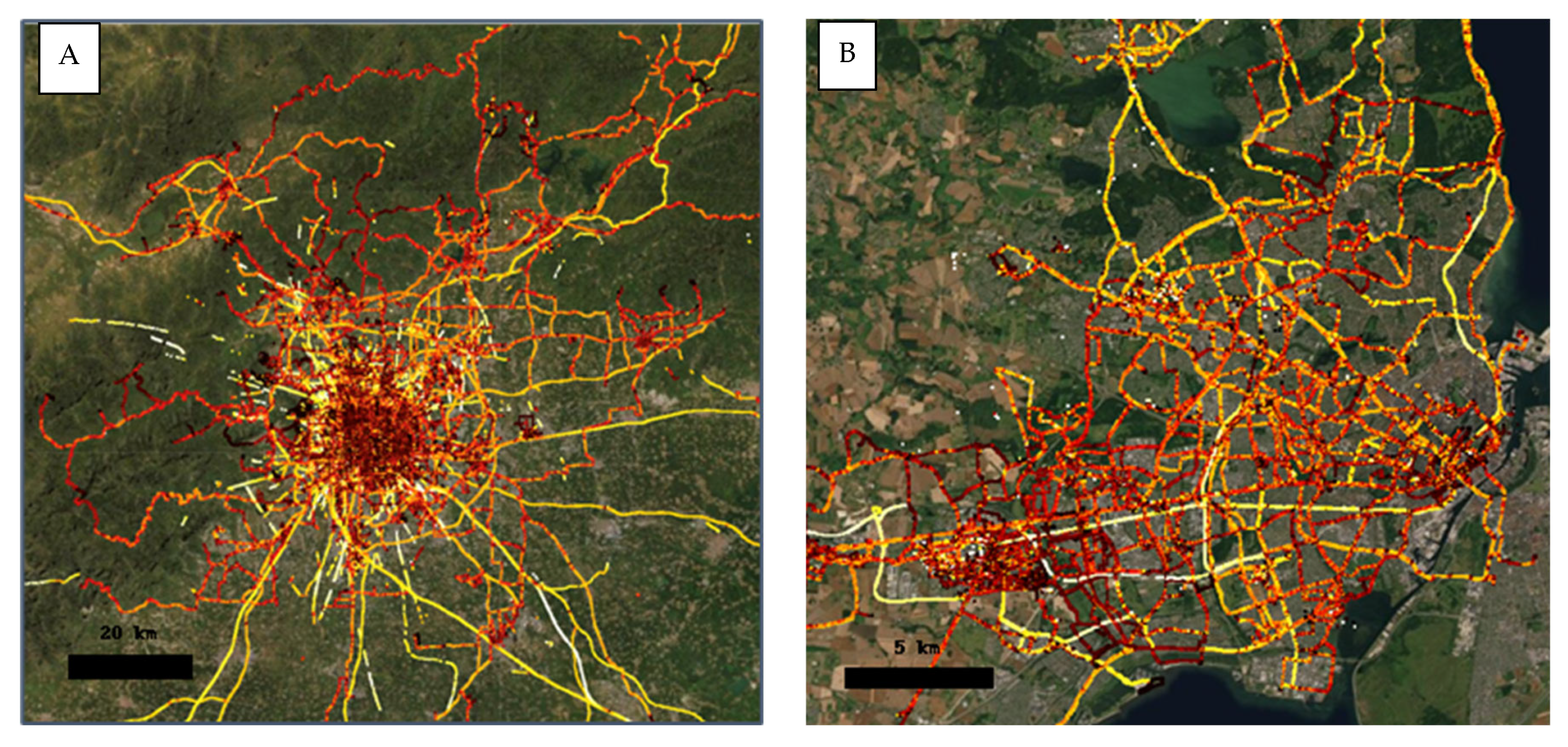


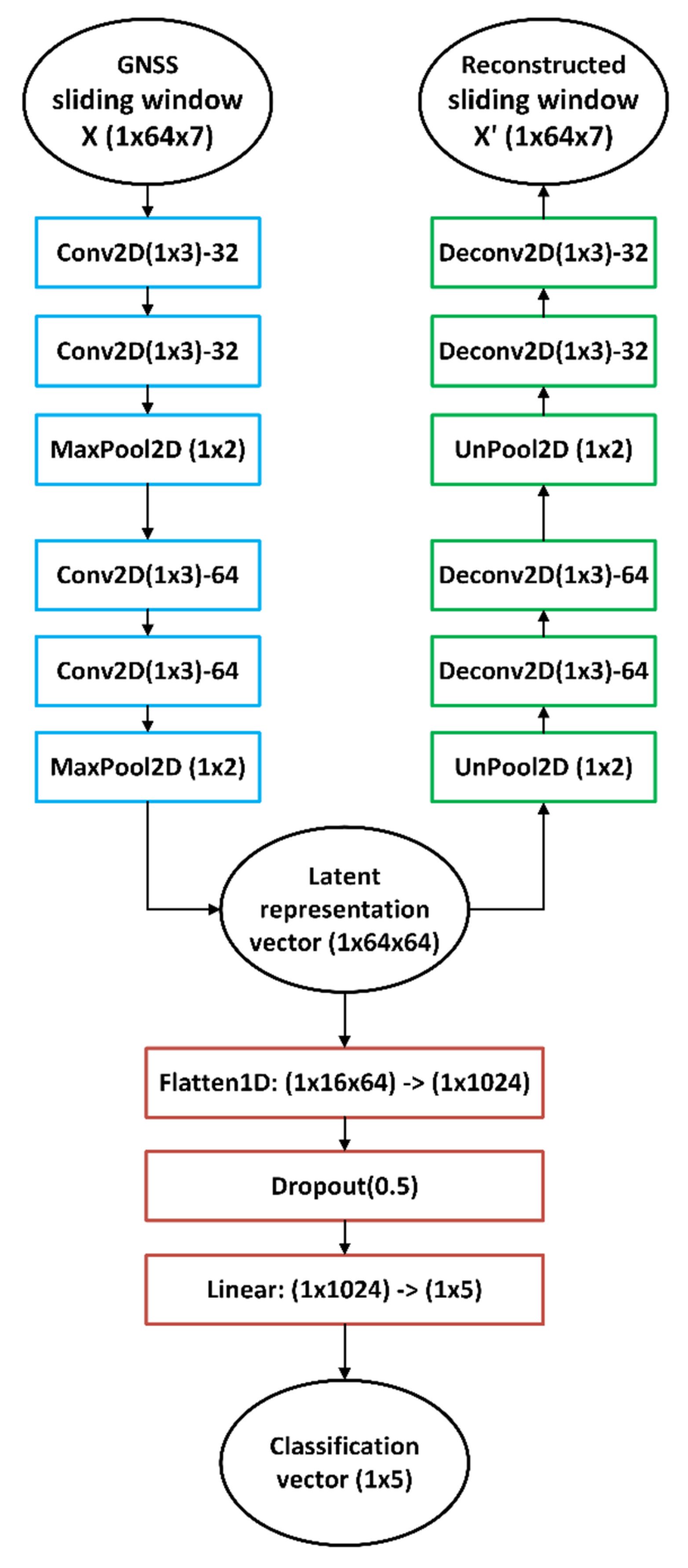
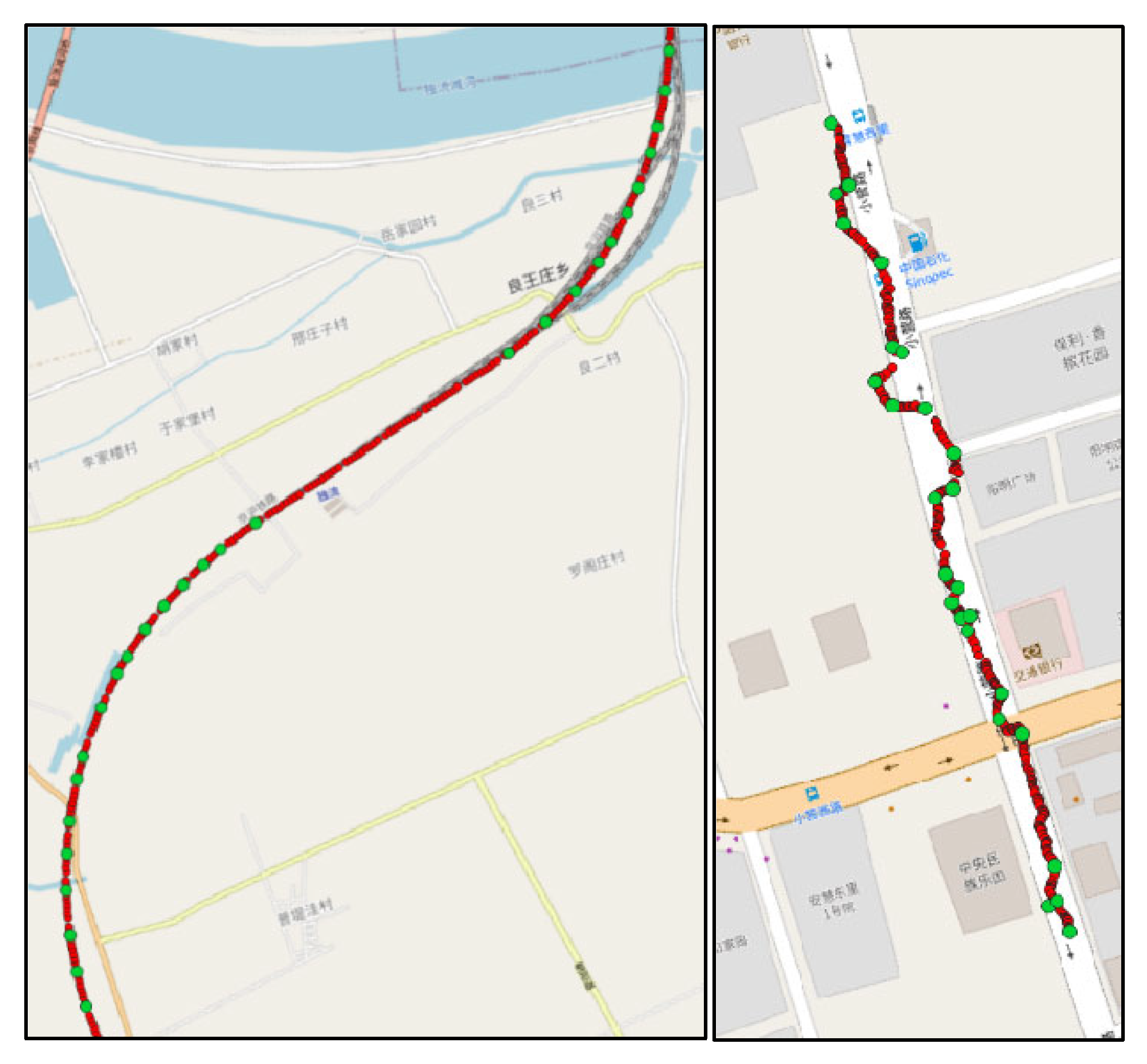

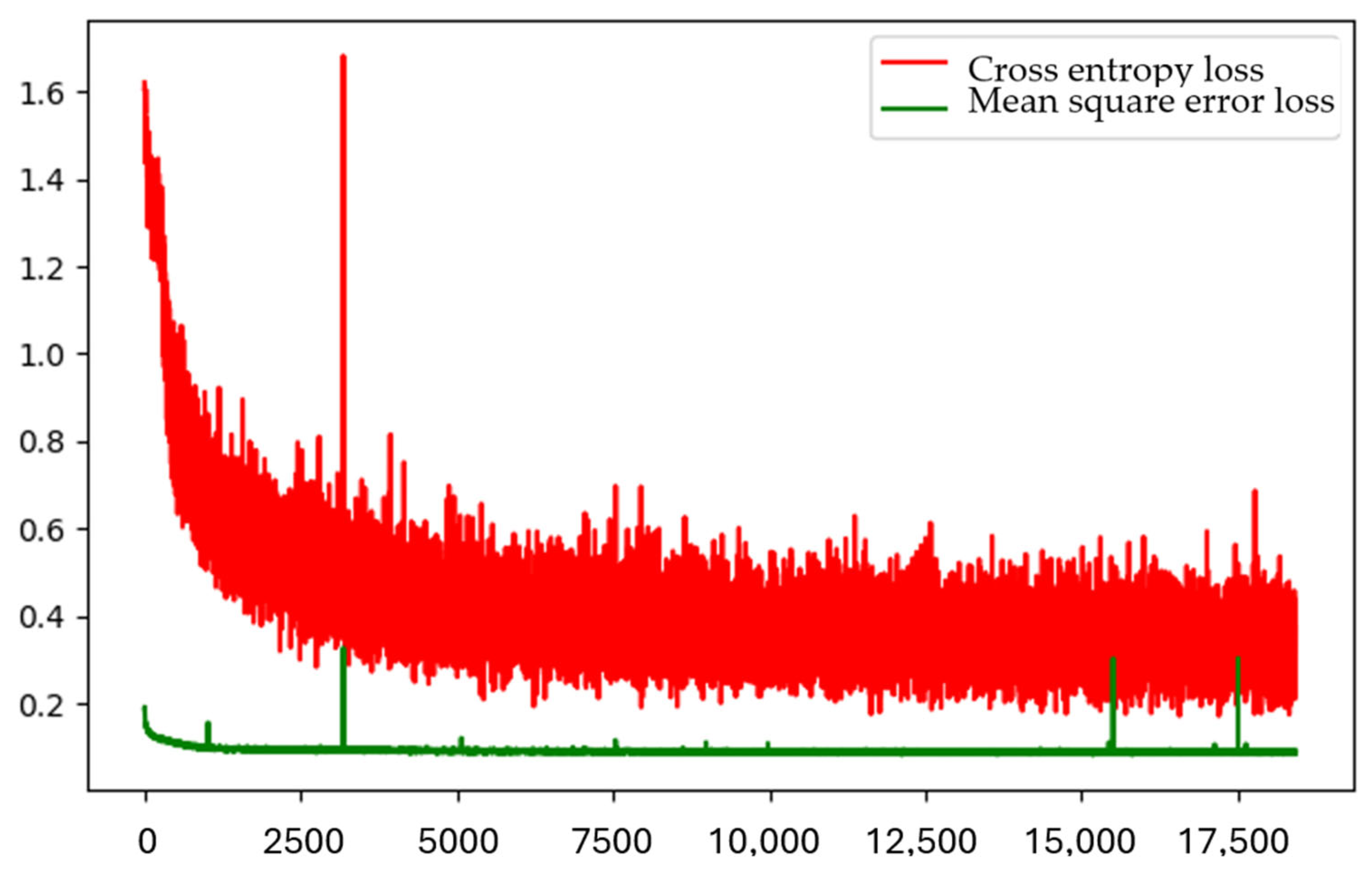
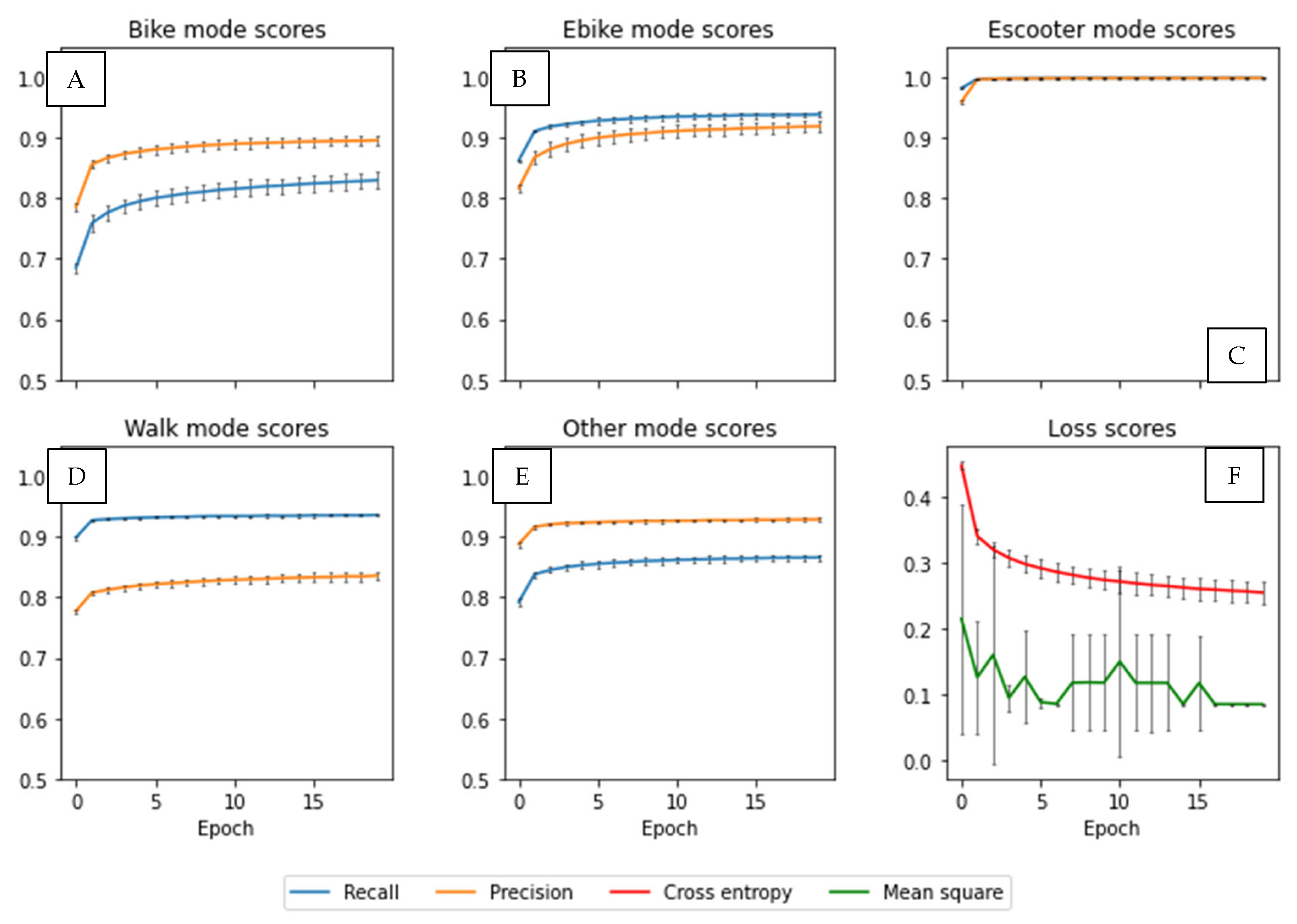


| Dataset | Location/Collection Date | Travel Mode | User Number | Trajectory Number | Total Hours | Total Kilometers | High Sampling Rate (0.2 hz–1 hz) | |||||
|---|---|---|---|---|---|---|---|---|---|---|---|---|
| Bike | e-Bike | e-Scooter | Walk | Other | Unlabeled | |||||||
| Geolife (A) Microsoft Research Asia [42] | China (mainly Beijing)/April 2007 to August 2012 | + | + | + | + | 182 | 18,670 | 631,483 (99% unlabeled) | 1861,195 (93% unlabeled) | 91.5% | ||
| Bernitt (B) Technical University of Denmark [43] | Denmark (mainly Copenhagen)/2014 to 2016 | + | 47 | 4339 | 2342 | 38,204 | 99.1% | |||||
| Bird (C) | Israel (Tel Aviv)/June 2020 | + | NA | 39,431 | 8156 | 272,434 | 97.1% | |||||
| MobilityNet (D) [44] | United States (San Franciso)/2020 | + | + | + | + | + | NA | NA | 466 | 27,748 | 91.2% | |
| Sultan (E) GPSies (acquired by Alltrails) (https://www.alltrails.com/explore (accessed on 12 July 2025)) [45] | Germany (Osnabruck) and The Netherlands (Amsterdam)/June 2015 | + | NA | 140 | 830 | 25,672 | 84.1% | |||||
| PedFlow (F) [46] | Israel (Tel Aviv)/July 2018 | + | 1 | 3 | 65 | 20 | 92.2% | |||||
| Method | Score | Bike | E-Bike | E-Scooter | Walk | Other |
|---|---|---|---|---|---|---|
| XGBoost64 | Recall | 75.9 | 93.8 | 100.0 | 93.1 | 86.4 |
| Precision | 67.4 | 97.3 | 100.0 | 70.0 | 95.3 | |
| F1-score | 71.4 | 95.5 | 100.0 | 79.9 | 90.6 | |
| xSeCA64 | Recall | 77.7 | 94.9 | 100.0 | 92.4 | 86.5 |
| Precision | 71.1 | 97.6 | 100.0 | 71.7 | 95.1 | |
| F1-score | 74.0 | 96.2 | 100.0 | 80.7 | 90.6 | |
| SeCA64 | Recall | 75.8 | 94.9 | 99.9 | 92.7 | 87.4 |
| Precision | 69.9 | 97.3 | 100.0 | 72.4 | 95.4 | |
| F1-score | 72.7 | 96.1 | 99.9 | 81.3 | 91.2 | |
| xSeCA32 | Recall | 71.3 | 93.6 | 99.9 | 92.8 | 82.0 |
| Precision | 67.6 | 96.7 | 99.9 | 65.9 | 94.9 | |
| F1-score | 69.1 | 95.1 | 99.9 | 77.0 | 88.0 | |
| SeCA32 | Recall | 71.3 | 93.2 | 99.7 | 91.3 | 83.9 |
| Precision | 65.7 | 96.6 | 99.9 | 66.2 | 94.6 | |
| F1-score | 68.3 | 94.9 | 99.8 | 76.8 | 88.9 |
| % of Data for Training | Convergence Epoch | Score | Bike | E-Bike | E-Scooter | Walk | Other |
|---|---|---|---|---|---|---|---|
| None | N.A. | Recall | 10.1 | 88.8 | 0.0 | 12.4 | 38.0 |
| Precision | 20.6 | 8.2 | 0.0 | 51.7 | 98.6 | ||
| F1-score | 13.5 | 15.0 | 0.0 | 20.0 | 54.9 | ||
| 5 | 7 | Recall | 80.9 | 61.0 | 68.9 | 97.3 | 90.5 |
| Precision | 85.3 | 59.9 | 70.2 | 89.4 | 94.7 | ||
| F1-score | 81.8 | 57.7 | 68.7 | 93.2 | 92.5 | ||
| 10 | 12 | Recall | 86.7 | 66.2 | 78.6 | 96.7 | 92.5 |
| Precision | 83.6 | 70.7 | 68.4 | 93.2 | 94.9 | ||
| F1-score | 84.9 | 67.9 | 72.4 | 94.9 | 93.7 | ||
| 20 | 16 | Recall | 88.5 | 74.5 | 82.7 | 97.2 | 93.6 |
| Precision | 81.9 | 75.5 | 73.2 | 95.7 | 95.8 | ||
| F1-score | 84.5 | 74.2 | 76.9 | 96.4 | 94.7 |
| Label | Relative Distance | Speed | Acceleration | Jerk | Bearing | Bearing Rate | RDP (0.5 m) |
|---|---|---|---|---|---|---|---|
| Bike | 3.3 | 4.84 | −1.13 | −1.19 | 4.63 | 2.95 | 0.91 |
| E-Bike | −7.2 | 3.69 | 3.74 | 5.7 | −5.06 | 0.2 | −0.5 |
| E-Scooter | 9.38 | −14.11 | 6.14 | 3.63 | 4.86 | −8.51 | 10.3 |
| Other | 1.32 | 7.23 | −0.25 | −0.32 | 1.73 | 1.59 | 1.81 |
| Walk | 1.17 | −2.04 | −0.18 | −0.21 | 1.91 | 1.78 | 1.94 |
| Average | 1.6 | −0.08 | 1.66 | 1.52 | 1.61 | −0.4 | 2.89 |
Disclaimer/Publisher’s Note: The statements, opinions and data contained in all publications are solely those of the individual author(s) and contributor(s) and not of MDPI and/or the editor(s). MDPI and/or the editor(s) disclaim responsibility for any injury to people or property resulting from any ideas, methods, instructions or products referred to in the content. |
© 2025 by the authors. Published by MDPI on behalf of the International Society for Photogrammetry and Remote Sensing. Licensee MDPI, Basel, Switzerland. This article is an open access article distributed under the terms and conditions of the Creative Commons Attribution (CC BY) license (https://creativecommons.org/licenses/by/4.0/).
Share and Cite
Lev-Ran, E.; Łukawska, M.; Servizi, V.; Dalyot, S. Cross-Domain Travel Mode Detection for Electric Micro-Mobility Using Semi-Supervised Learning. ISPRS Int. J. Geo-Inf. 2025, 14, 358. https://doi.org/10.3390/ijgi14090358
Lev-Ran E, Łukawska M, Servizi V, Dalyot S. Cross-Domain Travel Mode Detection for Electric Micro-Mobility Using Semi-Supervised Learning. ISPRS International Journal of Geo-Information. 2025; 14(9):358. https://doi.org/10.3390/ijgi14090358
Chicago/Turabian StyleLev-Ran, Eldar, Mirosława Łukawska, Valentino Servizi, and Sagi Dalyot. 2025. "Cross-Domain Travel Mode Detection for Electric Micro-Mobility Using Semi-Supervised Learning" ISPRS International Journal of Geo-Information 14, no. 9: 358. https://doi.org/10.3390/ijgi14090358
APA StyleLev-Ran, E., Łukawska, M., Servizi, V., & Dalyot, S. (2025). Cross-Domain Travel Mode Detection for Electric Micro-Mobility Using Semi-Supervised Learning. ISPRS International Journal of Geo-Information, 14(9), 358. https://doi.org/10.3390/ijgi14090358








